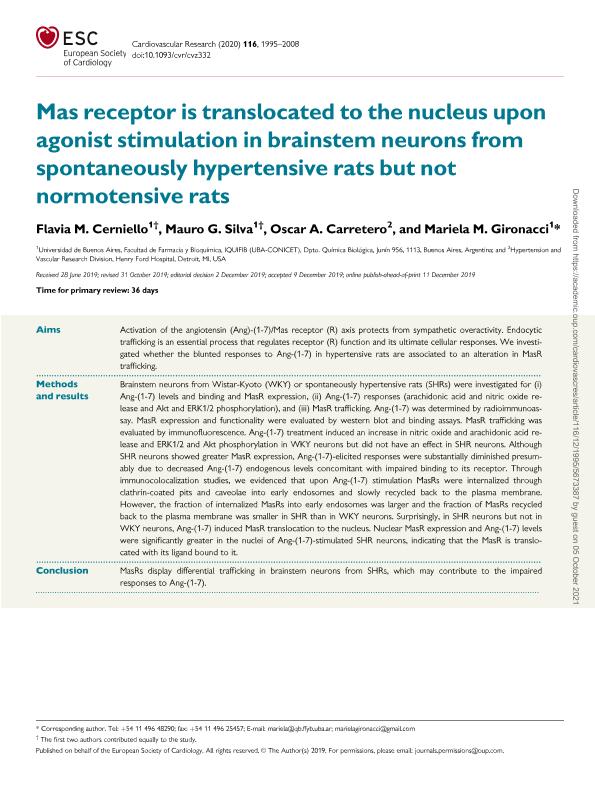Mostrar el registro sencillo del ítem
dc.contributor.author
Cerniello, Flavia Micaela

dc.contributor.author
Silva, Mauro Gastón

dc.contributor.author
Carretero, Oscar A.
dc.contributor.author
Gironacci, Mariela Mercedes

dc.date.available
2021-10-05T11:06:02Z
dc.date.issued
2020-06
dc.identifier.citation
Cerniello, Flavia Micaela; Silva, Mauro Gastón; Carretero, Oscar A.; Gironacci, Mariela Mercedes; Mas receptor is translocated to the nucleus upon agonist stimulation in brainstem neurons from spontaneously hypertensive rats but not normotensive rats; Oxford University Press; Cardiovascular Research; 116; 12; 6-2020; 1995-2008
dc.identifier.issn
0008-6363
dc.identifier.uri
http://hdl.handle.net/11336/142604
dc.description.abstract
Aims: Activation of the angiotensin (Ang)-(1-7)/Mas receptor (R) axis protects from sympathetic overactivity. Endocytic trafficking is an essential process that regulates receptor (R) function and its ultimate cellular responses. We investigated whether the blunted responses to Ang-(1-7) in hypertensive rats are associated to an alteration in MasR trafficking. Methods and results: Brainstem neurons from Wistar-Kyoto (WKY) or spontaneously hypertensive rats (SHRs) were investigated for (i) Ang-(1-7) levels and binding and MasR expression, (ii) Ang-(1-7) responses (arachidonic acid and nitric oxide release and Akt and ERK1/2 phosphorylation), and (iii) MasR trafficking. Ang-(1-7) was determined by radioimmunoassay. MasR expression and functionality were evaluated by western blot and binding assays. MasR trafficking was evaluated by immunofluorescence. Ang-(1-7) treatment induced an increase in nitric oxide and arachidonic acid release and ERK1/2 and Akt phosphorylation in WKY neurons but did not have an effect in SHR neurons. Although SHR neurons showed greater MasR expression, Ang-(1-7)-elicited responses were substantially diminished presumably due to decreased Ang-(1-7) endogenous levels concomitant with impaired binding to its receptor. Through immunocolocalization studies, we evidenced that upon Ang-(1-7) stimulation MasRs were internalized through clathrin-coated pits and caveolae into early endosomes and slowly recycled back to the plasma membrane. However, the fraction of internalized MasRs into early endosomes was larger and the fraction of MasRs recycled back to the plasma membrane was smaller in SHR than in WKY neurons. Surprisingly, in SHR neurons but not in WKY neurons, Ang-(1-7) induced MasR translocation to the nucleus. Nuclear MasR expression and Ang-(1-7) levels were significantly greater in the nuclei of Ang-(1-7)-stimulated SHR neurons, indicating that the MasR is translocated with its ligand bound to it. Conclusion: MasRs display differential trafficking in brainstem neurons from SHRs, which may contribute to the impaired responses to Ang-(1-7).
dc.format
application/pdf
dc.language.iso
eng
dc.publisher
Oxford University Press

dc.rights
info:eu-repo/semantics/openAccess
dc.rights.uri
https://creativecommons.org/licenses/by-nc-sa/2.5/ar/
dc.subject
ANGIOTENSIN-(1-7)
dc.subject
HYPERTENSION
dc.subject
MAS RECEPTOR
dc.subject
NEURON
dc.subject
RECEPTOR TRAFFICKING
dc.subject.classification
Bioquímica y Biología Molecular

dc.subject.classification
Ciencias Biológicas

dc.subject.classification
CIENCIAS NATURALES Y EXACTAS

dc.title
Mas receptor is translocated to the nucleus upon agonist stimulation in brainstem neurons from spontaneously hypertensive rats but not normotensive rats
dc.type
info:eu-repo/semantics/article
dc.type
info:ar-repo/semantics/artículo
dc.type
info:eu-repo/semantics/publishedVersion
dc.date.updated
2021-09-07T19:15:36Z
dc.journal.volume
116
dc.journal.number
12
dc.journal.pagination
1995-2008
dc.journal.pais
Reino Unido

dc.journal.ciudad
Oxford
dc.description.fil
Fil: Cerniello, Flavia Micaela. Consejo Nacional de Investigaciones Científicas y Técnicas. Oficina de Coordinación Administrativa Houssay. Instituto de Química y Físico-Química Biológicas "Prof. Alejandro C. Paladini". Universidad de Buenos Aires. Facultad de Farmacia y Bioquímica. Instituto de Química y Físico-Química Biológicas; Argentina
dc.description.fil
Fil: Silva, Mauro Gastón. Consejo Nacional de Investigaciones Científicas y Técnicas. Oficina de Coordinación Administrativa Houssay. Instituto de Química y Físico-Química Biológicas "Prof. Alejandro C. Paladini". Universidad de Buenos Aires. Facultad de Farmacia y Bioquímica. Instituto de Química y Físico-Química Biológicas; Argentina
dc.description.fil
Fil: Carretero, Oscar A.. Henry Ford Hospitall; Estados Unidos
dc.description.fil
Fil: Gironacci, Mariela Mercedes. Consejo Nacional de Investigaciones Científicas y Técnicas. Oficina de Coordinación Administrativa Houssay. Instituto de Química y Físico-Química Biológicas "Prof. Alejandro C. Paladini". Universidad de Buenos Aires. Facultad de Farmacia y Bioquímica. Instituto de Química y Físico-Química Biológicas; Argentina
dc.journal.title
Cardiovascular Research

dc.relation.alternativeid
info:eu-repo/semantics/altIdentifier/url/https://academic.oup.com/cardiovascres/article-abstract/116/12/1995/5673387?redirectedFrom=fulltext
dc.relation.alternativeid
info:eu-repo/semantics/altIdentifier/doi/http://dx.doi.org/10.1093/cvr/cvz332
Archivos asociados
